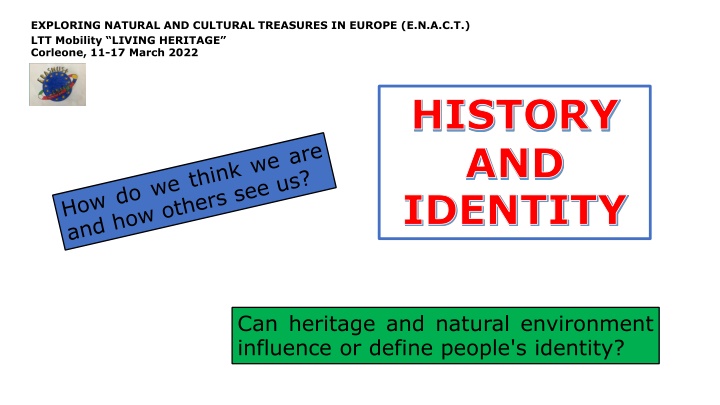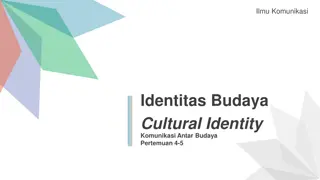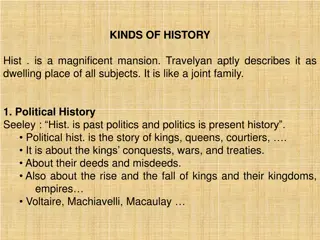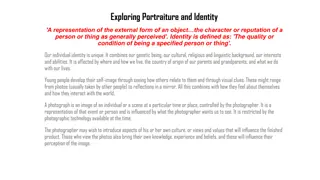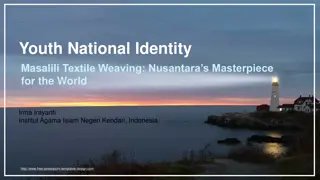HISTORY AND IDENTITY
Delve into how heritage and the natural environment shape people's identities during the E.N.A.C.T. Mobility in Corleone. Discover the intricate interplay between historical roots and personal sense of self, pondering the influence and definition these treasured aspects can have on individuals.
Download Presentation

Please find below an Image/Link to download the presentation.
The content on the website is provided AS IS for your information and personal use only. It may not be sold, licensed, or shared on other websites without obtaining consent from the author.If you encounter any issues during the download, it is possible that the publisher has removed the file from their server.
You are allowed to download the files provided on this website for personal or commercial use, subject to the condition that they are used lawfully. All files are the property of their respective owners.
The content on the website is provided AS IS for your information and personal use only. It may not be sold, licensed, or shared on other websites without obtaining consent from the author.
E N D
Presentation Transcript
EXPLORING NATURAL AND CULTURAL TREASURES IN EUROPE (E.N.A.C.T.) LTT Mobility LIVING HERITAGE Corleone, 11-17 March 2022 HISTORY AND IDENTITY Can heritage and natural environment influence or define people's identity?
NATURAL AND CULTURAL TREASURES IN CORLEONE
Corleone is a town of 10 614 inhabitants in the metropolitan city of Palermo in Sicily. It has very ancient origins dating back to the first phase of the Neolithic in the sixth millennium b.C. Before the Arabs occupied it in 840, Corleone was probably located on Montagna Vecchia, where recent excavations have brought to light the remains of an ancient city, perhaps the "Schera. Its inhabitants, perhaps in Roman times, came down from the plateau of the "Old" to colonize the basin below, where the Arabs later found it. Around 1072, the city was occupied by Normans and in 1104 it suffered the domination of the Saracens who in turn were defeated by Frederick II. Corleone boasts a huge artistic-ecclesial heritage and that is why it was called the "town of a hundred churches".
LETS REFLECT TOGETHER! WHICH IS IDENTITY? https://answergarden.ch/view/2379063
When you tell about Corleone, unfortunately, associate this name to a mafia s imagery, to faces brutalized by pain and contempt and to coppole (flat caps). If you know Corleone and you aren t from Sicily, it is because you have inherited it from Don Vito Corleone, the boss of The Godfather . It is important change your mind, dismantle a myth created by the media. Town of mafia The criminal activities of Cosa Nostra have caused damage to the image both to the municipality of Corleone and to the Corleonesi themselves, erroneously associated with the Corleonesi mafia clan. As a response, the Corleone community, since the nineties, has launched programs and projects that are such as to be an example of spontaneous territorial marketing. Town of legality
His fame began when his name was linked to the mafia family in the saga of the "Godfather" American films. In reality, the Corleone family does not exist, it is a cinematic fiction, but by many mistakenly believed to really exist), the reality is much more painful because the post-war Sicilian mafia is linked to the mafia "escalation" of Corleonesi bosses, who after various mafia wars took over the others by effectively commanding, through alliances all of Sicily. friendships and
THE C.I.D.M.A. C.I.D.M.A, International Center for Documentation on the Mafia and Anti- Mafia Movement holds the documents of the Maxi-trial, which marked a fundamental stage in the fight against the Cosa Nostra. The documents, donated to Corleone by the Criminal Chamber of the Court of Palermo, testify to the work of magistrates such as Giovanni Falcone and Paolo Borsellino, who paid with their lives for their commitment in the fight against the mafia.
Volunteer groups in various non-profit associations have contributed to Corleone's image through social campaigns in favor of legality declined in days for legality, educational courses in schools, competitions, exhibitions on the mafia, presentation of books, etc. overlapped cooperatives that work the land confiscated from Mafia bosses. changing artistic photographic with the
THE TWIN FORTRESSES AND THE PARK OF CASCATA DELLE DUE ROCCHE The fortresses . These are two high and isolated cliffs that have become a real symbol of the city. To the east of the inhabited center is the Rocca Soprana. It can be reached by passing in front of the churchyard of the church of San Michele Arcangelo and continuing along a path that runs alongside the fortress itself, in the middle of a medieval maze of small alleys. The Soprano Castle was built in the 9th century and was built by the Arabs as a watchtower for the defense of Corleone. It consists of a cylindrical volume covered by a sort of dry stone masonry dome. The turret at the top is defined as "Saracen", but the dating is rather doubtful. It was already in ruins in the 18th century. Rocca Sottana is located in the center of Corleone, on the opposite side from the Soprana one. Of the original medieval complex, located on a monolith on the right bank of the river, probably only the surrounding walls remain. The building has a rectangular and irregular shape and is composed of several buildings leaning against each other.It was renovated by the Bourbons around 1845 and used as a prison until 1968. Today, properly adapted, it has become a Franciscan hermitage where the Renovated Friars Minor live. Corleonese landscape is dominated by the Twin
A architectural works of Corleone must be completed by an excursion to the natural park of the CASCATA DELLE DUE ROCCHE and the Corleone stream, which flows through the heart of the town. Comfortably seated on ancient square boulders, in the shade of mulberries, walnuts and ash trees, you can observe the suggestive spectacle of the waterfall. With its erosive action, the water jump of the stream has formed a large pool among the limestone rocks. The Cascata delle Due Rocche is a very important site from a botanical and geological point of view. It is the habitat of various endemic plant and animal species. 4 meters high, it is formed by a jump of the San Leonardo river, a tributary of the Belice. All around the glauconite rocks, made alive by erosion in their yellow and green colors, are covered by rock vegetation. Looking closely at the walls you can see the remains of an ancient aqueduct. Before throwing itself at this point, further upstream the stream exerted a strong excavation action along the rocky sides, forming the Canyon. To admire its beauties it is possible to get there by climbing a path that starts from the Benedictine monastery of SS. Salvatore, to the right of the church. visit to the countless and interesting historical and
CHURCH OF SANTAGOSTINO The CHURCH OF SANT AGOSTINO was founded in Corleone by the Augustinians. interesting from an artistic point of view is the choir which has splendid paintings and a Baroque altar. The origins of this church date back to the fourteenth century, although it was later modified in the Baroque era. Inside it houses the painting by Giuseppe Ribera depicting the martyrdom of St. Bartholomew and a large canvas that reproduces moments from the life of St. Augustine. The neoclassical layout has a single rectangular hall with barrel vaulted with decorated panels can be appreciated. It has side altars slightly embedded in the wall and two small portals in polychrome church is the oratory of Sant Agostino, a room whose walls are entirely covered with frescoes, stuccos, paintings and Corleonese Santo Governali. Particularly lunettes, on which marble.Adjacent to the wood painted by the
THE MOTHER CHURCH The cathedral of Corleone is dedicated to the bishop of Tours, San Martino and its construction has gone through long and troubled events. In fact, the original medieval layout (13th century), completed in 1148, was replaced by the configuration, based on a project by the architect- priest Antonio Romano (1786). It has a basilica layout with three naves divided by pillars with centric arches, a semicircular apse and a drum dome with windows at the graft of the transept with the central nave. In the side aisles there are five chapels on each side, adorned with paintings and sculptures of a certain value. Furthermore, a real heritage of art is preserved in the sacristy.Also noteworthy are some frontals (in the presbytery), with gold and silver embroidery and applications of pearls on red velvet, the work of the female monastic circles of the city (Benedictine, 17th- 19th centuries). Finally, in the choir, you can admire over a rich collection of sacred vestments, numerous works by Fra Felice da Sambuca. current neoclassical
THE CIVIC MUSEUM OF CORLEONE The Civic Museum of Corleone is located in the historic center of the town, in a building owned by the Provenzano family. The building, dating back to the mid-nineteenth century, has decorations made with stucco and paintings and the flooring is in majolica. The museum is named after the Corleonese futurist painter Pippo Rizzo (1897 - 1964). The eight rooms of the museum house various types of finds. The archaeological collection includes objects found in the archaeological site on the Old Mountain, which belong to different eras: Paleolithic, Mesolithic, Neolithic, Bronze Age, Iron Age, Classical Greek period, Hellenistic and Roman period, Medieval period. Among the most interesting objects, the only Roman milestone found in Sicily, which attests the LVII miles that separated Agrigento from the site where it was located. The epigraph "Aurelio Cotta Console" traces the piece back to 252 b.C. .
The king had a palace designed and built to serve as his residence. The works for its construction began in 1802 and lasted until 1807. Of neoclassical style, the palace, with a rectangular plan, basement cellar at the time used as a food reserve, with a ground floor and a first floor. In the front elevation there is the main entrance which was used by the king to enter his residence directly with the carriage. To the left of the building is the entrance for the servants; on the right, however, the entrance to the royal chapel (still used today). The main floor is at the top of a staircase made of red marble from local quarries (Scalilli) along which it is possible to admire two reliefs on sandstone representing the Bourbon eagles with the royal coat of arms. From here starts a long corridor in which the royal apartment and the lodgings for the nobles follow one another that the king hosted on the occasion of parties and hunting trips that he himself organized. Rocca meters) limestone massif, overlooks a huge green expanse full of valleys and streams in which countless animal and plant species live. extremity it is possible to admire the entire wooded area, now a nature reserve. This splendid bewitched Ferdinand IV of Bourbon. He territory to use it as a royal hunting reserve, his main passion. Busambra is (1915 imposing FICUZZA AND THE KING FERDINAND IV an consists of a From its landscape chose this meticulously
